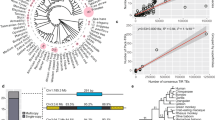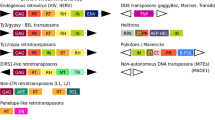Abstract
piggyBac is a short inverted-repeat-type DNA transposable element originally isolated from the genome of the moth Trichoplusia ni. It is currently the gene vector of choice for the transformation of various insect species. A few sequences with similarity to piggyBac have previously been identified from organisms such as humans ( Looper), the pufferfish Takifugu rubripes (Pigibaku), Xenopus (Tx), Daphnia (Pokey), and the Oriental fruit fly Bactrocera dorsalis. We have now identified 50 piggyBac-like sequences from publicly available genome sequences and expressed sequence tags (ESTs). This survey allows the first comparative examination of the distinctive piggyBac transposase, suggesting that it might contain a highly divergent DDD domain, comparable to the widespread DDE domain found in many DNA transposases and retroviral integrases which consists of two absolutely conserved aspartic acids separated by about 70 amino acids with a highly conserved glutamic acid about 35 amino acids further away. Many piggyBac-like sequences were found in the genomes of a phylogenetically diverse range of organisms including fungi, plants, insects, crustaceans, urochordates, amphibians, fishes and mammals. Also, several instances of "domestication" of the piggyBac transposase sequence by the host genome for cellular functions were identified. Novel members of the piggyBac family may be useful in genetic engineering of many organisms.

Similar content being viewed by others
References
Altschul SF, Madden TL, Schaffer AA, Zhang J, Zhang Z, Miller W, Lipman DJ (1997) Gapped BLAST and PSI-BLAST: a new generation of protein database search programs. Nucleic Acids Res 25:3389–402
Aparicio S, et al (2002) Whole-genome shotgun assembly and analysis of the genome of Fugu rubripes. Science 297:1301–1310
Beall EL, Mahoney MB, Rio DC (2002) Identification and analysis of a hyperactive mutant form of Drosophila P -element transposase. Genetics 162:217–227
Carroll D, Knutson DS, Garrett JE (1989) Transposable elements in Xenopus species. In: Berg DE, Howe MM (eds) Mobile DNA. ASM Press, Washington, D.C, pp 567–574
Cary LC, Goebel M, Corsaro BG, Wang HG, Rosen E, Fraser MJ (1989) Transposon mutagenesis of baculoviruses: analysis of Trichoplusia ni transposon IFP2 insertions within the FP-locus of nuclear polyhedrosis viruses. Virology 172:156–169
Craig NL, Craigie RC, Gellert M, Lambowitz AM (2002) Mobile DNA II. ASM Press, Washington D.C.
Davies DR, Braam LM, Reznikoff WS, Rayment I (1999) The three-dimensional structure of a Tn5 transposase-related protein determined to 2.9-Å resolution. J Biol Chem 274:11904–11913
Dehal P, et al (2002) The draft genome sequence of Ciona intestinalis: insights into chordate and vertebrate origins. Science 298:2157–2167
Doak TG, Doerder FP, Jahn CL, Herrick G (1994) A proposed superfamily of transposase genes: transposon-like elements in ciliated protozoa and a common "D35E" motif. Proc Natl Acad Sci USA 91:942–946
Fraser MJ (2000) The TTAA-specific family of transposable elements: identification, functional characterization, and utility for transformation of insects. In: Handler AH, James AA (eds) Insect transgenesis. CRC Press, Boca Raton, pp 249–270
Fraser MJ, Cary L, Boonvisudhi K, Wang HG (1995) Assay for movement of lepidopteran transposon IFP2 in insect cells using a baculovirus genome as a target DNA. Virology 211:397–407
Fraser MJ, Ciszczon T, Elick T, Bauser C (1996) Precise excision of TTAA-specific lepidopteran transposons piggyBac ( IFP2) and tagalong ( TFP3) from the baculovirus genome in cell lines from two species of Lepidoptera. Insect Mol Biol 5:141–151
Gardner MJ, (2002) Genome sequence of the human malaria parasite Plasmodium falciparum. Nature 419:498–511
Grossman GL, Rafferty CS, Clayton JR, Stevens TK, Mukabayire O, Benedict MQ (2001) Germline transformation of the malaria vector, Anopheles gambiae , with the piggyBac transposable element. Insect Mol Biol 10:597–604
Handler AM (2002) Use of the piggyBac transposon for germ-line transformation of insects. Insect Biochem Mol Biol 32:1211–1220
Handler AM, Harrell RA 2nd (1999) Germline transformation of Drosophila melanogaster with the piggyBac transposon vector. Insect Mol Biol 8:449–457
Handler AM, McCombs SD (2000) The piggyBac transposon mediates germ-line transformation in the Oriental fruit fly and closely related elements exist in its genome. Insect Mol Biol 9:605–612
Holt RA, et al (2002) The genome sequence of the malaria mosquito Anopheles gambiae. Science 298:129–149
Horn C, Wimmer EA (2000) A versatile vector set for animal transgenesis. Dev Genes Evol 210:630–637
Horn C, Offen N, Nystedt S, Hacker U, Wimmer EA (2003) piggyBac -based insertional mutagenesis and enhancer detection as a tool for functional insect genomics. Genetics 163:647–661
International Human Genome Sequencing Consortium (2001) Initial sequencing and analysis of the human genome. Nature 409:860–921
Jurka J (2000) Repbase update: a database and an electronic journal of repetitive elements. Trends Genet 16:418–420
Kipling D, Warburton PE (1997) Centromeres, CENP-B and Tigger too. Trends Genet 13:141–145
Kumar S, Hedges SB (1998) A molecular timescale for vertebrate evolution. Nature 392:917–920
Lobo NF, Hua-Van A, Li X, Nolen BM, Fraser MJ (2002) Germ line transformation of the yellow fever mosquito, Aedes aegypti , mediated by transpositional insertion of a piggyBac vector. Insect Mol Biol 11:133–139
Mouse Genome Sequencing Consortium (2002) Initial sequencing and comparative analysis of the mouse genome. Nature 420:520–562
Nolan T, Bower TM, Brown AE, Crisanti A, Catteruccia F (2002) piggyBac -mediated germline transformation of the malaria mosquito Anopheles stephensi using the red fluorescent protein dsRED as a selectable marker. J Biol Chem 277:8759–8762
Peloquin JJ, Thibault ST, Staten R, Miller TA (2000) Germ-line transformation of pink bollworm (Lepidoptera: Gelechiidae) mediated by the piggyBac transposable element. Insect Mol Biol 9:323–333
Penton EH, Sullender BW, Crease TJ (2002) Pokey, a new DNA transposon in Daphnia (Cladocera: Crustacea). J Mol Evol 55:664–673
Robertson HM (2002) Evolution of DNA transposons in eukaryotes. In: Craig NL, Craigie R, Gellert M, Lambowitz AM (eds) Mobile DNA II. ASM Press, Washington, D.C., pp 1093–1110
Robertson HM, Lampe DJ (1995) Recent horizontal transfer of a mariner transposable element among and between Diptera and Neuroptera. Mol Biol Evol 12:850–862
Schmidt HA, Strimmer K, Vingron M, von Haeseler A (2002) TREE-PUZZLE: maximum likelihood phylogenetic analysis using quartets and parallel computing. Bioinformatics 18:502–504
Smit AF (1999) Interspersed repeats and other mementos of transposable elements in mammalian genomes. Curr Opin Genet Dev 9:657–663
Swofford DL (2002) PAUP*: Phylogenetic Analysis Using Parsimony and Other Methods. Sinauer Press, New York
Tamura T, et al (2000) Germline transformation of the silkworm Bombyx mori L. using a piggyBac transposon-derived vector. Nat Biotechnol 18:81–84
Thompson JD, Gibson TJ, Plewniak F, Jeanmougin F, Higgins DG (1997) The ClustalX windows interface: flexible strategies for multiple sequence alignment aided by quality analysis tools. Nucleic Acids Res 24:4876–4882
Unsal K, Morgan GT (1995) A novel group of families of short interspersed repetitive elements (SINEs) in Xenopus: evidence of a specific target site for DNA-mediated transposition of inverted-repeat SINEs. J Mol Biol 248:812–823
Wang HG, Fraser MJ (1993) TTAA serves as the target site for TFP3 lepidopteran transposon insertions in both nuclear polyhedrosis virus and Trichoplusia ni genomes. Insect Mol Biol 1:109–116
Zieler H, Huynh CQ (2002) Intron-dependent stimulation of marker gene expression in cultured insect cells. Insect Mol Biol 11:87–95
Acknowledgements
The work described here was supported by NIH grants GM58826 (HMR) and P01AI45123 (P.I. Frank Collins), NIH cooperative agreement U01AI48846 (P.I. Frank Collins) and NIH cooperative agreement U01AI50687-01 (Large scale sequencing and assembly of the An. gambiae genome; P.I. Robert A. Holt, Celera Genomics)
Author information
Authors and Affiliations
Corresponding author
Additional information
Communicated by G. P. Georgiev
Electronic Supplementary Material
Rights and permissions
About this article
Cite this article
Sarkar, A., Sim, C., Hong, Y.S. et al. Molecular evolutionary analysis of the widespread piggyBac transposon family and related "domesticated" sequences. Mol Genet Genomics 270, 173–180 (2003). https://doi.org/10.1007/s00438-003-0909-0
Received:
Accepted:
Published:
Issue Date:
DOI: https://doi.org/10.1007/s00438-003-0909-0




